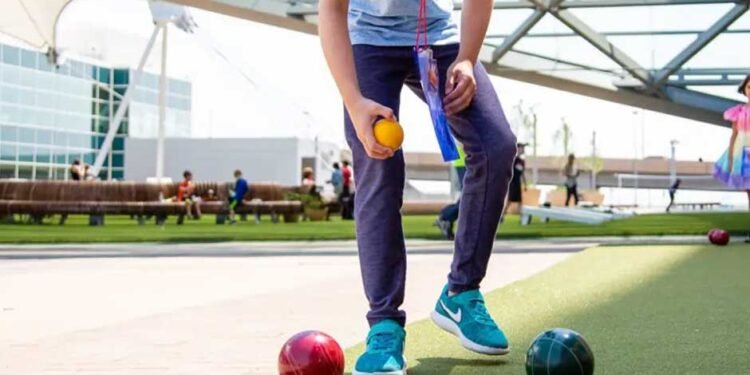Bocce ball, an ancient game with roots in the Roman Empire, has seen a resurgence in popularity in recent years. Whether you’re a seasoned player or new to the sport, having a well-constructed court can significantly enhance your playing experience.
This article will guide you through the process of bocce ball court installation, covering everything from planning to maintenance.
Understanding Bocce Ball
Before diving into the specifics of court installation, it’s important to understand the basics of bocce ball and why having a proper court is essential.
What is Bocce Ball?
Bocce ball is a popular target sport where players or teams aim to roll their bocce balls as close as possible to a smaller target ball known as the pallino.
Played on a long and narrow court, the game requires a combination of precision, strategy, and a little bit of luck. Its simplicity and competitive nature make it a favorite for casual and competitive play alike.
Why a Proper Court Matters
A well-constructed bocce ball court ensures a consistent ball roll, which is vital for fair play. It also enhances the playing experience by providing a smooth, level surface.
Beyond that, having a proper bocce court adds value to your property, creating a space for outdoor gatherings and entertainment. Whether for personal enjoyment or hosting events, a good bocce court can become a key feature of any backyard or recreational area.
Planning Your Bocce Ball Court
When planning your bocce ball court, several factors need to be carefully considered to ensure a successful installation.
Location
The first step is choosing the right location. Ideally, the area should be level and have good natural drainage. It’s also recommended that the court be oriented north-south to minimize sun glare, which can interfere with play. Selecting a spot with these conditions will create a more enjoyable and functional bocce ball experience.
Size
While official bocce courts measure 13 feet wide by 91 feet long, most recreational courts can be smaller. A typical recreational bocce ball court measures about 10 feet wide by 60 feet long, which is sufficient for casual play. The size of your court will depend on the available space in your yard and your intended use.
Materials
The choice of materials for your bocce ball court will influence its performance, maintenance needs, and aesthetics. Common materials include crushed stone, decomposed granite, sand, artificial turf, or an oyster shell blend. Each material has its benefits and drawbacks, depending on your climate and maintenance preferences.
Budget
The bocce ball court installation cost can vary widely depending on size, materials, and whether you hire professionals or do it yourself. We’ll cover a detailed breakdown of potential costs later in this guide, but understanding your budget will help guide decisions throughout the process.
How to Install a Bocce Ball Court: Step-by-Step Guide
Now that you’ve planned your bocce ball court let’s walk through the installation process to ensure you get the best results.
Step 1: Mark and Excavate the Area
Start by marking the court area using stakes and string to ensure straight lines. Once the area is outlined, excavate to a depth of 4-6 inches, ensuring the ground is level and well-compacted. This forms the foundation of your court and is crucial for even play.
Step 2: Install Drainage (If Needed)
If your chosen location has poor drainage, it’s important to install a drainage system. A French drain system, which involves laying perforated pipes in trenches filled with gravel, is a popular choice.
Proper drainage will prevent water from pooling on your court after rain, keeping it playable and in good condition.
Step 3: Build the Frame
Construct a sturdy frame for your court using pressure-treated lumber or concrete blocks. Ensure the frame is both level and square, as this structure will hold the court materials in place and maintain its shape over time.
Step 4: Add Base Layers
Once the frame is in place, lay a weed barrier fabric over the excavated area to prevent future growth of weeds. Next, add a 2-3 inch layer of crushed stone or gravel, ensuring it’s well-compacted. This base layer provides drainage and stability for the playing surface.
Step 5: Install the Playing Surface
Now it’s time to add your chosen playing surface, whether it be decomposed granite, artificial turf, or an oyster shell blend. Spread the material evenly, then level and compact it to create a smooth, consistent playing field.
For multi-layer courts, finer materials such as sand or crushed shells can be added on top to complete the surface.
Step 6: Add Finishing Touches
To finish, you can install bumper boards along the sides of the court to keep balls from rolling off. Add court markings with paint or chalk to create boundaries and start zones, ensuring your court is ready for play.
Bocce Ball Court Installation Cost
The cost of installing a bocce ball court varies depending on several factors, such as the size of the court, the materials used, and whether you hire professionals.
Factors Affecting Cost
The overall cost will be influenced by the size of your court, the types of materials selected for both the base and the playing surface, and any professional services required. Additionally, features such as drainage systems, lighting, or seating areas can increase the final cost.
Cost Estimates
For those opting for a DIY installation using basic materials, the total cost could range from $500 to $1,000.
However, for a professional installation with premium materials, costs can soar to between $5,000 and $15,000 or more. It’s always a good idea to get quotes from local contractors to better understand the pricing in your area.
Maintaining Your Bocce Ball Court
Once your court is installed, proper maintenance is key to ensuring it remains in great condition for years to come.
Regular Maintenance Tasks
To keep the court in top shape, it’s important to rake the surface regularly to maintain a level playing field. Removing debris such as leaves or twigs and lightly watering the surface can help prevent dust if you’re using decomposed granite.
Additionally, repairing any damage to the frame or surface promptly will ensure the court stays functional and safe.
Seasonal Maintenance
At the change of seasons, it’s a good idea to inspect and clean the drainage systems, especially before rainy periods.
In colder climates, you may need to protect the court from freeze-thaw cycles, which can cause damage. Replenishing surface materials annually will also keep the court in optimal condition.
Enhancing Your Bocce Ball Court
Once the court is complete, consider adding a few features to enhance the overall playing experience.
Lighting
Installing overhead lights or ground-level LED strips will allow for evening play, extending the use of the court beyond daylight hours.
Seating Areas
Adding benches or chairs along the sidelines can provide comfortable seating for players and spectators, creating a more social environment.
Storage
Consider building a small shed or cabinet to store bocce balls and maintenance tools. This keeps your equipment organized and the court area tidy.
Landscaping
Incorporate landscaping around the court, such as shrubs or flowers, to seamlessly integrate the bocce court into your yard’s design, making it both functional and visually appealing.
Common Mistakes to Avoid in Bocce Ball Court Installation
Learning from common mistakes made during bocce ball court installations can save you time, money, and frustration.
Inadequate Drainage
Poor drainage is a frequent issue that can leave your court unplayable after rain. Be sure to prioritize a proper drainage system during installation to avoid this problem.
Uneven Surface
A bumpy or sloped court can affect the way the balls roll, leading to an unsatisfactory playing experience. Taking the time to ensure the court is perfectly level is essential for consistent play.
Using the Wrong Materials
Not all materials are suitable for all climates, so be sure to research what works best in your area. The wrong materials could lead to constant maintenance and repair issues down the road.
Incorrect Dimensions
While bocce courts don’t always need to be regulation-sized, it’s important to make sure your court is long and narrow enough for enjoyable play. Avoid cutting corners on dimensions.
Neglecting the Frame
A solid frame is key to maintaining the court’s shape and structure. Neglecting to include this important element can lead to a degraded court over time.
Conclusion
Installing a bocce ball court can be a rewarding project that provides years of enjoyment. By following this guide, you’ll be well-equipped to tackle your bocce ball court installation, whether you choose to do it yourself or hire professionals.
Remember, the key to a great bocce ball court lies in careful planning, proper installation, and regular maintenance. With attention to these details, you’ll create a court that not only enhances your property but also provides a fantastic venue for friendly competition and social gatherings.
So, grab your bocce balls, invite some friends, and get ready to enjoy this classic game in the comfort of your own backyard. Your new bocce ball court awaits!












